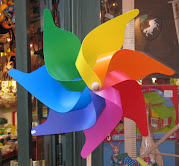
I want to return to my friend Karin's diploma essays for the Craighead Institute which I was reading over the weekend. (You can find some discussion of the previous post here - don't think I ever really expected to be quoted alongside Camille Paglia but such are the wonders of the hyperlinked world - merci J.K!)
Karin calls her reflections on Martha and Mary the unity of contemplation & action - you can read the biblical story in Luke 10: 38-42 - and begins in Nuremberg, her home town, in the St Lorenz church where there is an altar to St Martha. (There is also a St Martha church where the altar was originally - and strangely this church is now Reformed, rather than Lutheran)
I was fascinated to discover that Martha is seen as a tamer of dragons and working together with Saint George on the icon at the bottom of this site - mind you I dare say this lack of knowledge of saintly iconography just marks me out as an illiterate Protestant!
Anyway as usual I digress.
To return to Karin who says, "The altar combines biblical records with ancient sources and medieval legends. It also does not hide the conflict between Martha and Mary. However, the Biblical story gets an interesting twist: the iconography of the altar ignores Jesus’ judgement (Luke 10: 41f), instead Martha is depicted as the host, who serves Jesus faithfully and who is asking her sister to do the same. The other pictures of the altar show Martha healing a possessed, vanquishing a dragon and resurrecting a dead person to life."
Karin states that the Martha altar shows an earlier and different sensibility to Martin Luther's harsh appreciation of her, “Martha, your work must be punished and regarded for nothing … I do not want any work but Mary’s, and that is faith.”
that of mysticism:
"Meister Eckhart “moved the still immature Mary to the initial stage of spiritual life, but regarded the mature and experienced Martha as having closer proximity to what is needed.”observing, “Martha was afraid that her sister would get stuck in sweetness and well-being.’ Martha wishes Mary to be like herself … ‘Therefore Christ said and meant: Be calm Martha, she, too, has chosen the good part. This part will get lost from her, but the highest good will be bestowed upon her. She will be blessed like you.
Teresa of Avila takes the interpretation of the mystics one step further; the concepts – contemplation and action, which Mary and Martha stand for, are complementary: “Believe me, Martha and Mary must be together to accommodate the Lord and keep him with them forever; otherwise he will be served poorly and remain without food. How could Mary who always sat at his feet have offered him food if her sister had not jumped in? And his food is our gathering souls, that they may be saved and praise him in eternity.’”
I have to admit that with advancing middle age I rather like the sound of the "mature and experienced Martha" - but then like generations of capable women I have always rather over-identified with Martha even when I was a lot younger. When I first preached on the passage I didn't quite feel able to follow my mother's exegesis of the passage - which consisted of something along the lines of oh well, Jesus would say that wouldn't he, men always want you to listen to what they're saying - but I can see that many male and female preachers have struggled with the opposing role models that the two sisters seem to offer.
I'm grateful to Karin's work, and that of other sholars, for encouraging women (and men) to dare to integrate action and spirituality and take on realistic and complex role models rather than monochrome or dichotomous ones. Contemplation of Martha and Mary should not lead us to despise or judge either of the sisters - even if the gospel may seem to - we need to find a "sisterly" interpretation - perhaps even wider than that we need to find a "geschwisterliche" (sibling) interpretation - ie a non-gender specific interpretation.
Karin concludes her initial reflections on Martha and Mary by citing one of my favourite theologians.
"For the German Protestant theologian, Dorothee Sölle, Martha and Mary become icons for women’s leadership: “… the best women I know will no longer accept the separation of the two. … legend lets both cross the ocean with Jesus’ disciples to teach and preach, making them act and dream, do the good work and pray, uniting struggle and reflection and, in the process, making the world itself more sisterly.”
So dragon slayer or quiet and careful listener Martha and Mary can speak to us of the ever present creative tension between contemplation and action.
Karin concludes by saying
"Bible studies, contemplation and prayer challenge me to move from activity to prophetic action. Social justice issues demand authentic expressions of my faith ... I realize, that I am part of complex processes in my organization. Martha and Mary teach me to stay focused and to ask for and to seek in planning processes this balance."
Tuesday, 22 April 2008
Martha and Mary as role models - a Dragon tamer for the eve of St George's day
Publié par Jane à l'adresse 21:33
Libellés : Bible, Feminist theology, management, Spirituality
Subscribe to:
Post Comments (Atom)






2 Comments:
Jane,
You say so much more so much better and so much more importantly than Camille Paglia.
On Mary and Martha, thank you very much for sharing Dorothee Sölle's and Karin's insights. Have you seen Carolyn Custis James's discussion of Mary of Bethany as the first theologian (as in her book When Life and Beliefs Collide reviewed at Christianity Today)?
Thanks for the link to Curtis. I didn't know of her work - more things to add to my reading list. Work is the curse of the reading classes!
I'm not quite as opinionated as Camille Paglia - but I keep trying! :-)
Post a Comment